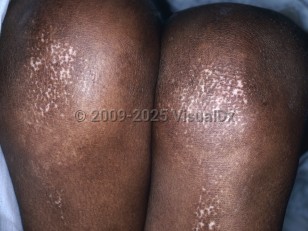Sclerodermatomyositis
Alerts and Notices
Important News & Links
Synopsis

Sclerodermatomyositis is an uncommon overlap syndrome that presents in both adolescents and adults and satisfies diagnostic criteria for both scleroderma and dermatomyositis or polymyositis. Myositis may appear simultaneously before or during already established scleroderma. Of the overlap syndromes, sclerodermatomyositis is one of the most frequently encountered and heterogenous syndromes.
Sclerodermatomyositis mostly occurs in women, with a peak onset typically at 35-40 years of age. There is a strong association of sclerodermatomyositis with HLA-DR3, HLA DQA1*0501, and HLA-DQB1*02. The course of the disease is chronic but is generally mild with a good prognosis, particularly when associated with an antibody directed against the nucleolar antigen PM-Scl, present in about 70%-90% of sclerodermatomyositis cases.
Childhood sclerodermatomyositis usually begins before age 12 and may present insidiously with myalgia or suddenly with fever, arthritis, myalgia, or Raynaud phenomenon. Cutaneous features usually begin during the first year of the disease. Muscle and cutaneous findings consistent with dermatomyositis are usually transient, while features of scleroderma may persist. Like adults, visceral involvement in children is rare.
Sclerodermatomyositis mostly occurs in women, with a peak onset typically at 35-40 years of age. There is a strong association of sclerodermatomyositis with HLA-DR3, HLA DQA1*0501, and HLA-DQB1*02. The course of the disease is chronic but is generally mild with a good prognosis, particularly when associated with an antibody directed against the nucleolar antigen PM-Scl, present in about 70%-90% of sclerodermatomyositis cases.
Childhood sclerodermatomyositis usually begins before age 12 and may present insidiously with myalgia or suddenly with fever, arthritis, myalgia, or Raynaud phenomenon. Cutaneous features usually begin during the first year of the disease. Muscle and cutaneous findings consistent with dermatomyositis are usually transient, while features of scleroderma may persist. Like adults, visceral involvement in children is rare.
Codes
ICD10CM:
M35.1 – Other overlap syndromes
SNOMEDCT:
238936001 – Sclerodermatomyositis
M35.1 – Other overlap syndromes
SNOMEDCT:
238936001 – Sclerodermatomyositis
Look For
Subscription Required
Diagnostic Pearls
Subscription Required
Differential Diagnosis & Pitfalls

To perform a comparison, select diagnoses from the classic differential
Subscription Required
Best Tests
Subscription Required
Management Pearls
Subscription Required
Therapy
Subscription Required
References
Subscription Required
Last Reviewed:01/28/2019
Last Updated:02/28/2019
Last Updated:02/28/2019
Sclerodermatomyositis

